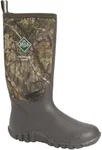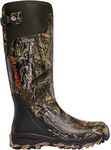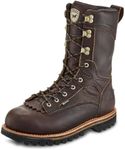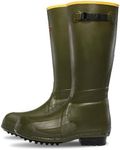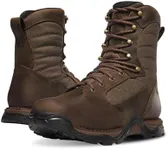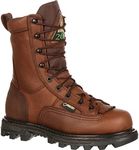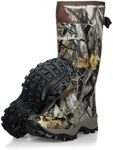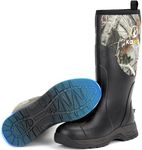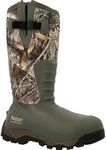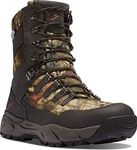Buying Guide for the Best Waterproof Hunting Boots
Choosing the right waterproof hunting boots is crucial for a successful and comfortable hunting experience. The right pair will keep your feet dry, provide good traction, and offer the necessary support for long hours in the field. Here are some key specifications to consider when selecting waterproof hunting boots and how to navigate them to find the best fit for your needs.WaterproofingWaterproofing is the ability of the boots to keep water out, ensuring your feet stay dry in wet conditions. This is important because wet feet can lead to discomfort, blisters, and even hypothermia in cold weather. Look for boots with waterproof membranes like Gore-Tex or proprietary technologies from reputable brands. If you hunt in extremely wet environments, prioritize high-quality waterproofing.
InsulationInsulation in hunting boots helps keep your feet warm in cold weather. This is measured in grams, with higher numbers indicating more insulation. For mild weather, 200-400 grams of insulation is sufficient. For colder conditions, 600-800 grams is better, and for extreme cold, 1000 grams or more may be necessary. Choose the insulation level based on the typical temperatures you will be hunting in.
TractionTraction refers to the grip the boots provide on various surfaces. Good traction is essential for stability and safety, especially on slippery or uneven terrain. Boots with deep lugs and aggressive tread patterns offer better grip. If you hunt in mountainous or muddy areas, prioritize boots with excellent traction.
Fit and ComfortFit and comfort are crucial for preventing blisters and ensuring you can walk long distances without pain. Boots should fit snugly but not too tight, with enough room to wiggle your toes. Consider trying on boots with the socks you plan to wear while hunting. Look for features like padded collars, cushioned insoles, and adjustable lacing systems for added comfort.
DurabilityDurability refers to how well the boots can withstand rough conditions and prolonged use. This is important because hunting often involves traversing rugged terrain. Look for boots made from high-quality materials like full-grain leather or durable synthetics. Reinforced areas, such as the toe and heel, can also enhance durability.
HeightBoot height affects ankle support and protection from water and debris. Taller boots (8-10 inches) offer better ankle support and are ideal for rough terrain and deep water. Shorter boots (6-7 inches) are lighter and more flexible, suitable for less challenging environments. Choose the height based on the terrain and conditions you expect to encounter.
WeightWeight is the overall heaviness of the boots. Lighter boots are easier to walk in and reduce fatigue, which is important for long hunts. However, heavier boots often provide more support and durability. Balance the need for lightweight comfort with the need for support and protection based on your hunting style and the terrain.
